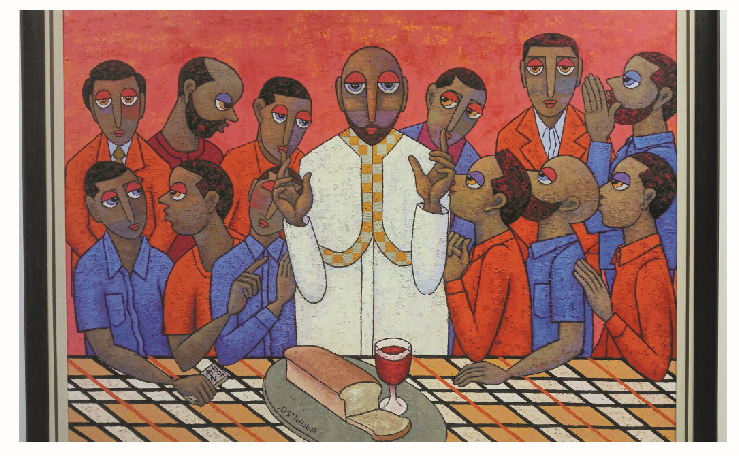In this first edition of spotted at the gallery, we break down the painting of The Last Supper by the artist Adubi.
In this contemporised version of Leonardo da Vinci’s Last Supper, artist Adubi gives Jesus and his apostles a middle-eastern-north African heritage, Jesus spotting a bald head, and his apostles with close-cropped hair. Three figures stand out, Jesus robed in white standing amidst the twelve disciples – six on his right and on his left. St John the Beloved with his oft-effeminate features, leaning on Jesus, and Judas Iscariot who holds a 1000 note of indeterminate currency in his hand lying on the table.
On the sparsely filled table covered by a plaid tablecloth lies a tray of sliced bread and a glass of wine. The tablecloth is a play on Jesus’ garment, a white kaftan-ish robe with an ochre and red-plaid collar, which not only separated the viewer from the figures in the painting, but contrasts with the its background colour.
Adubi’s use of contrasting colours in the framing (of red-blue-red on one side of Jesus, and blue-red-blue on the other) makes for a balanced image. We also see his masterful colour control in the red on orange background, and orange on orange hue. The figures attires range from formal traditional wears as worn by Jesus, and to the suits, t-shirts and collar shirts on his disciples.
Painted in 2020, this striking painting hanging at the top floor of Thought Pyramid art gallery is timely, as the Catholic Church enters the Passion Week. It is a reminder of the solemn period the Church and its faithful re-witness looking at the solemn faces of Jesus and his apostles who are distressed at Jesus’ revelation that one of them would betray him.
The artist’s choice of a single loaf of bread and a glass of wine seems a reference to Jesus feeding of the 5000 and 4000, and his ability to cater to our needs, not just the physical but our spiritual needs as well.
I love the artist’s draughtsmanship, the grainy aesthetic of the artwork and the line work that gives the painting an illustrative feel, but for its life-size.
With this painting, Adubi makes the Lord and his apostles more relatable to us, by placing the event in our contemporary setting. One can easily discern which of the disciple one is – the whispering one or the attentive ones, the ones who love the most or the ones most loved, or perhaps the traitor. It is a call for reflection for a soul as the Church rounds off the Lenten Season with the Triduum activities.










